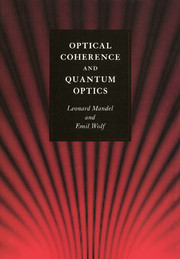Book contents
- Frontmatter
- Contents
- Preface
- 1 Elements of probability theory
- 2 Random (or stochastic) processes
- 3 Some useful mathematical techniques
- 4 Second-order coherence theory of scalar wavefields
- 5 Radiation from sources of any state of coherence
- 6 Second-order coherence theory of vector electromagnetic fields
- 7 Some applications of second-order coherence theory
- 8 Higher-order correlations in optical fields
- 9 Semiclassical theory of photoelectric detection of light
- 10 Quantization of the free electromagnetic field
- 11 Coherent states of the electromagnetic field
- 12 Quantum correlations and photon statistics
- 13 Radiation from thermal equilibrium sources
- 14 Quantum theory of photoelectric detection of light
- 15 Interaction between light and a two-level atom
- 16 Collective atomic interactions
- 17 Some general techniques for treating interacting systems
- 18 The single-mode laser
- 19 The two-mode ring laser
- 20 The linear light amplifier
- 21 Squeezed states of light
- 22 Some quantum effects in nonlinear optics
- References
- Author index
- Subject index
2 - Random (or stochastic) processes
Published online by Cambridge University Press: 05 April 2013
- Frontmatter
- Contents
- Preface
- 1 Elements of probability theory
- 2 Random (or stochastic) processes
- 3 Some useful mathematical techniques
- 4 Second-order coherence theory of scalar wavefields
- 5 Radiation from sources of any state of coherence
- 6 Second-order coherence theory of vector electromagnetic fields
- 7 Some applications of second-order coherence theory
- 8 Higher-order correlations in optical fields
- 9 Semiclassical theory of photoelectric detection of light
- 10 Quantization of the free electromagnetic field
- 11 Coherent states of the electromagnetic field
- 12 Quantum correlations and photon statistics
- 13 Radiation from thermal equilibrium sources
- 14 Quantum theory of photoelectric detection of light
- 15 Interaction between light and a two-level atom
- 16 Collective atomic interactions
- 17 Some general techniques for treating interacting systems
- 18 The single-mode laser
- 19 The two-mode ring laser
- 20 The linear light amplifier
- 21 Squeezed states of light
- 22 Some quantum effects in nonlinear optics
- References
- Author index
- Subject index
Summary
Introduction to statistical ensembles
The concept of a random or stochastic process or function represents a generalization of the idea of a set of random variables x1, x2, …, when the set is no longer countable and the variables form a continuum. We therefore introduce a continuous parameter t, such as time, that labels the variates. We call x(t) a random process or a random function of t if x does not depend on t in a deterministic way. Random processes are encountered in many fields of science, whenever fluctuations are present. Examples of a real random process x(t) are the fluctuating voltage across an electrical resistor, and the coordinates of a particle under-going Brownian motion. We shall see shortly that the optical field generated by any realistic light source must also be treated as a random function of position and time. Of course the parameter t may also stand for some quantity other than time, but for simplicity we shall take it to represent time. In our applications x(t) will frequently represent a Cartesian component of the electric or magnetic field vector in a light beam. To begin with we shall take x(t) to be real, but complex random processes will also be encountered.
The ensemble average
As x does not depend on t deterministically, we can only describe its values statistically, by some probability distribution or probability density.
- Type
- Chapter
- Information
- Optical Coherence and Quantum Optics , pp. 41 - 91Publisher: Cambridge University PressPrint publication year: 1995
- 1
- Cited by



